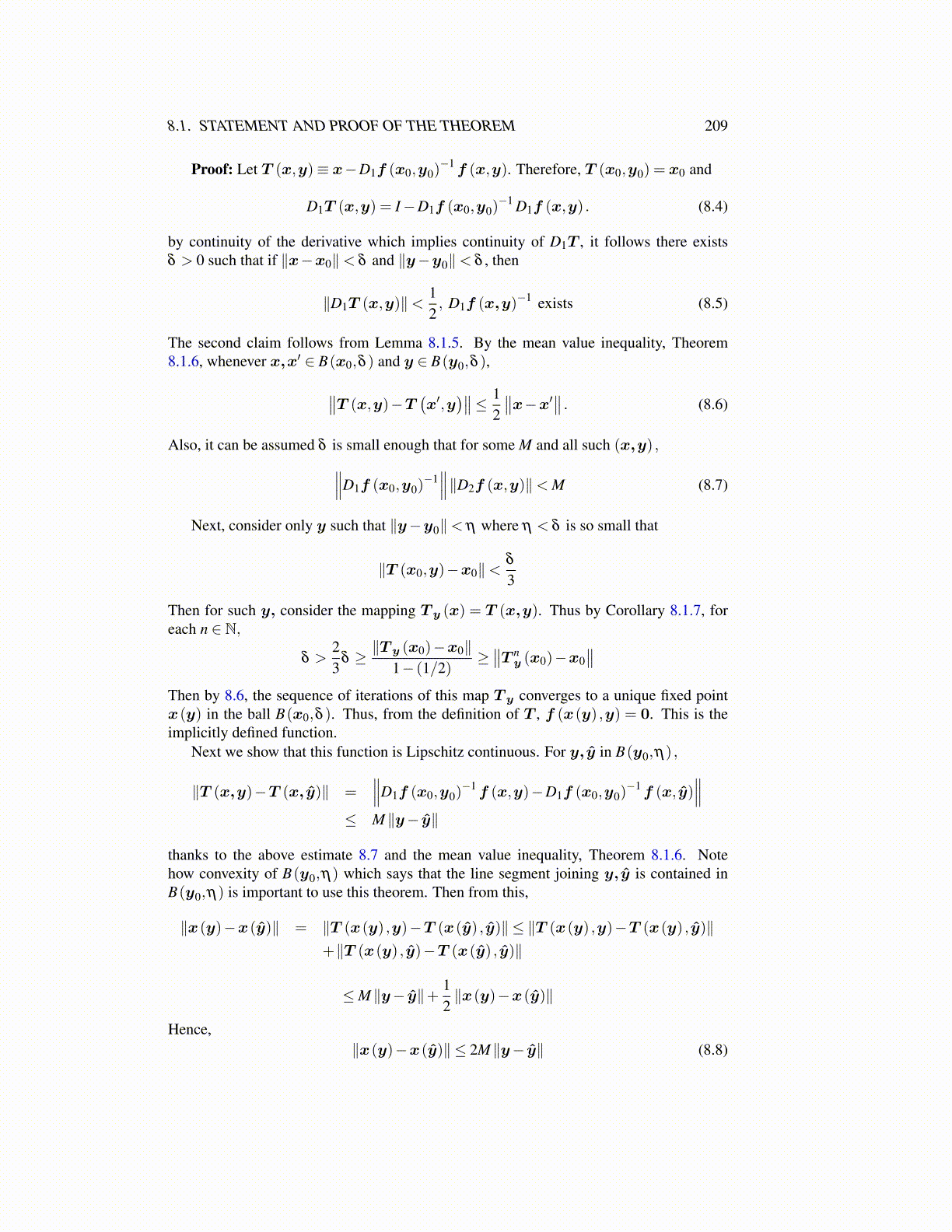
8.1. STATEMENT AND PROOF OF THE THEOREM 209
Proof: Let T (x,y)≡ x−D1f (x0,y0)−1f (x,y). Therefore, T (x0,y0) = x0 and
D1T (x,y) = I−D1f (x0,y0)−1 D1f (x,y) . (8.4)
by continuity of the derivative which implies continuity of D1T , it follows there existsδ > 0 such that if ∥x−x0∥< δ and ∥y−y0∥< δ , then
∥D1T (x,y)∥< 12, D1f (x,y)
−1 exists (8.5)
The second claim follows from Lemma 8.1.5. By the mean value inequality, Theorem8.1.6, whenever x,x′ ∈ B(x0,δ ) and y ∈ B(y0,δ ),∥∥T (x,y)−T
(x′,y
)∥∥≤ 12
∥∥x−x′∥∥ . (8.6)
Also, it can be assumed δ is small enough that for some M and all such (x,y) ,∥∥∥D1f (x0,y0)−1∥∥∥∥D2f (x,y)∥< M (8.7)
Next, consider only y such that ∥y−y0∥< η where η < δ is so small that
∥T (x0,y)−x0∥<δ
3
Then for such y, consider the mapping T y (x) = T (x,y). Thus by Corollary 8.1.7, foreach n ∈ N,
δ >23
δ ≥ ∥T y (x0)−x0∥1− (1/2)
≥∥∥T n
y (x0)−x0∥∥
Then by 8.6, the sequence of iterations of this map T y converges to a unique fixed pointx(y) in the ball B(x0,δ ). Thus, from the definition of T , f (x(y) ,y) = 0. This is theimplicitly defined function.
Next we show that this function is Lipschitz continuous. For y,ŷ in B(y0,η) ,
∥T (x,y)−T (x,ŷ)∥ =∥∥∥D1f (x0,y0)
−1f (x,y)−D1f (x0,y0)−1f (x, ŷ)
∥∥∥≤ M ∥y− ŷ∥
thanks to the above estimate 8.7 and the mean value inequality, Theorem 8.1.6. Notehow convexity of B(y0,η) which says that the line segment joining y,ŷ is contained inB(y0,η) is important to use this theorem. Then from this,
∥x(y)−x(ŷ)∥ = ∥T (x(y) ,y)−T (x(ŷ) , ŷ)∥ ≤ ∥T (x(y) ,y)−T (x(y) , ŷ)∥+∥T (x(y) , ŷ)−T (x(ŷ) , ŷ)∥
≤M ∥y− ŷ∥+ 12∥x(y)−x(ŷ)∥
Hence,∥x(y)−x(ŷ)∥ ≤ 2M ∥y− ŷ∥ (8.8)